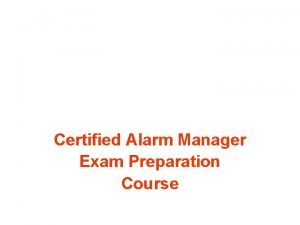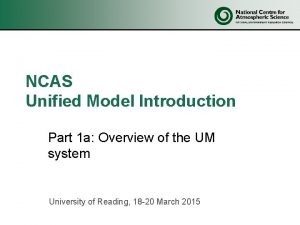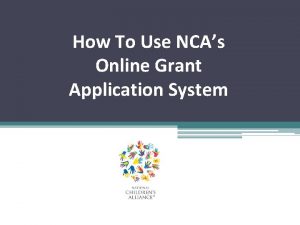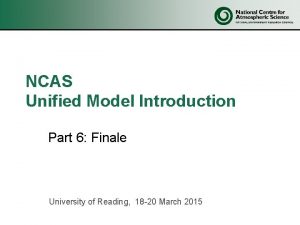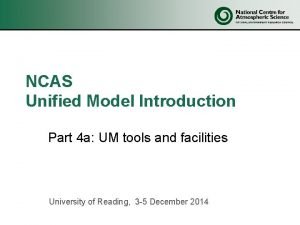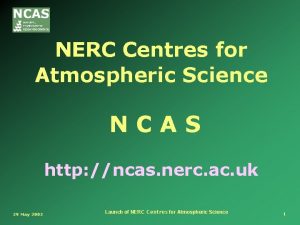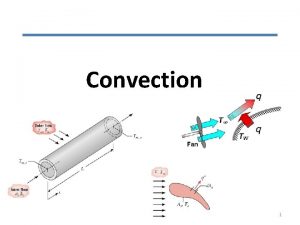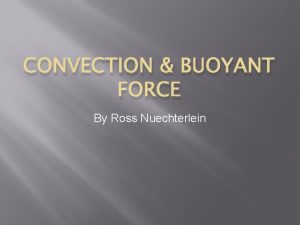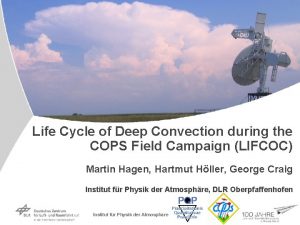http www ncas ac uk UK COPS Convection











- Slides: 11

http: //www. ncas. ac. uk UK COPS: Convection and Transport in Complex Terrain (CATICT) Alan Blyth and Stephen Mobbs 1 COPS Workshop 25 Sept 2006

http: //www. ncas. ac. uk Valle y Layout of CATICT Instruments Karlsruhe Stuttgart Strasbourg ne S 2 Rhi S 4 2 S 1 Freiburg S 3 Tuttlingen COPS Workshop 25 Sept 2006

http: //www. ncas. ac. uk What Don't We Understand? How to accurately predict thermally driven flows. The fluid dynamics is represented reasonably well but the crucial surface exchanges of heat and moisture which drive the flow are not. How deep convective cells interact with the boundary layer and therefore how does air get drawn up into deep convective cells over the mountains? How biogenic and anthropogenic aerosols regulate the growth & activation of cloud condensation nuclei & ice nuclei and thereby control clouds and precipitation. How does deep orographic convection influence regional scale redistribution of aerosols & chemical species? 3 COPS Workshop 25 Sept 2006

http: //www. ncas. ac. uk CATICT Questions and Objectives How do orographic flows generate the horizontal convergence necessary for development of deep convective cells? OBJ 1 To quantify the inflow to orographically-locked convective cells along two lines, one along a valley in the mountain range (the valley route) and one directly over the mountains (the direct route), following the evolution through the lifecycles of the cells. OBJ 2 To quantify the relative roles of valley and non-valley inflows in orographically-locked convective cells over a range of tropospheric conditions (stability, wind structure) and through the life-cycles of the cells. OBJ 3 To determine the factors controlling whether anabatic up-valley and upmountain-range flows are trapped or penetrate the free troposphere. OBJ 4 To determine the critical factors (e. g. surface fluxes, resolution, stability) affecting the ability of the Met Office UM to reproduce the observed inflows to orographically-locked convection. 4 COPS Workshop 25 Sept 2006

http: //www. ncas. ac. uk CATICT Questions and Objectives How are aerosols and short-lived chemical species lifted by these orographic flows from the surface into the free troposphere in complex terrain? OBJ 5 To quantify the boundary-layer fluxes of aerosols into orographicallylocked convective cells through the valley and direct routes. OBJ 6 To determine the role of boundary-layer convective elements (thermals, detrainment mechanisms, clouds) in mixing aerosols into the free troposphere. OBJ 7 To determine the factors affecting the ability of the Met Office UM to reproduce the observed fluxes of aerosols and chemical species into orographically-locked convection. OBJ 8 To determine the evolution of both short and long-lived chemical species (e. g. isoprene, ozone) in the convective boundary layer and to relate these to air mass history. 5 COPS Workshop 25 Sept 2006

http: //www. ncas. ac. uk CATICT Questions and Objectives How does the orographic convection and precipitation depend on aerosols and the microphysics and dynamics of the clouds? OBJ 9 To quantify the aerosol distributions and composition in cloud inflow and in the cloud environment which are needed for cloud models. OBJ 10 To determine the important microphysical and dynamical processes responsible for the development of precipitation in the orographic clouds. OBJ 11 To test the ability of cloud resolving models to reproduce the observed cloud microphysics, dynamics and precipitation and the response of these to the variability in measured aerosol properties. OBJ 12 To determine, by comparing models with observations, how the orographic cumulus congestus clouds process the aerosols, thereby influencing the aerosols ingested into the clouds. 6 COPS Workshop 25 Sept 2006

http: //www. ncas. ac. uk CATICT Questions and Objectives What influence do orographically-locked convective systems have on the regional-scale redistribution of aerosols and chemical species and hence on the further development of precipitation and air quality? OBJ 13 To quantify the concentrations of aerosols and trace chemical species upwind and downwind of orographic convection in the free troposphere. OBJ 14 To determine the factors affecting the ability of the Met Office UM to reproduce the upwind--downwind changes in aerosol concentration across orographic convection. 7 COPS Workshop 25 Sept 2006

http: //www. ncas. ac. uk Possible CATICT Instruments 8 COPS Workshop 25 Sept 2006

http: //www. ncas. ac. uk FAAM BAe 146 Aircraft 9 COPS Workshop 25 Sept 2006

http: //www. ncas. ac. uk FAAM BAe 146 Aircraft Instruments 10 COPS Workshop 25 Sept 2006

http: //www. ncas. ac. uk 11 COPS Workshop 25 Sept 2006
 Rabbit words orton-gillingham
Rabbit words orton-gillingham Cops monitoring 10024 vanderbilt circle rockville md 20850
Cops monitoring 10024 vanderbilt circle rockville md 20850 Il clown killer
Il clown killer Cops monitoring 10024 vanderbilt circle rockville md 20850
Cops monitoring 10024 vanderbilt circle rockville md 20850 Ncas introduction
Ncas introduction Ncas application
Ncas application Ncas introduction
Ncas introduction Ncas cms
Ncas cms Ncas introduction
Ncas introduction Http //mbs.meb.gov.tr/ http //www.alantercihleri.com
Http //mbs.meb.gov.tr/ http //www.alantercihleri.com Http //pelatihan tik.ung.ac.id
Http //pelatihan tik.ung.ac.id Convection plates
Convection plates

